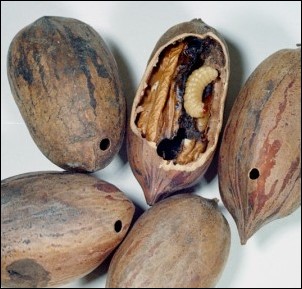Homeowners urged to take action now to prevent fall disappointment with infested pecans
By Jessica Strickland
Wayne County Horticulture Extension Agent
Early Warning Signs Signal Weevil Emergence
As August approaches, Wayne County homeowners with pecan trees should begin preparing for the annual emergence of pecan weevils, according to local extension experts. Those who have noticed pecans dropping prematurely from their trees may already be seeing signs that these destructive pests are emerging from the ground.
Jessica Strickland, Agriculture Extension Agent specializing in horticulture for North Carolina Cooperative Extension in Wayne County, emphasizes that pecan weevils typically emerge from the ground between August and September, particularly after significant rainfall of one inch or more.
Two Types of Damage Threaten Pecan Harvest
The pecan weevil causes distinct types of damage that can devastate a home pecan harvest. Adult weevils, described as reddish-brown, gray beetles with long slender snouts and thin legs, puncture nuts in early August, causing them to fall within two to three days.
The second type of damage occurs when larvae feed within the nut itself. These creamy white, legless grubs with reddish-brown heads eventually chew circular holes through the shell and exit the nut as it falls to the ground, burrowing into the soil to complete their life cycle.
Understanding the Life Cycle Key to Control
The timing of control measures becomes critical when understanding the pecan weevil’s life cycle. Adult weevils emerge from soil during the August-to-September window, with many flying directly to tree trunks or canopies while others walk up the trees. Female weevils puncture developing pecans and lay eggs inside, where larvae mature before exiting and burrowing into soil to remain until the following August.
“You want to control the adult weevils as they are emerging from the ground because they cannot be reached once they are in the nut or while they are in the soil,” Strickland explains.
Multiple Control Options Available
For those choosing chemical control, Strickland recommends applications of carbaryl (Sevin) insecticide every 7 to 10 days from mid-August through mid-September, following product label recommendations.
Alternative and supplementary control methods include gathering and destroying weevil-infested nuts as they fall to prevent larvae from entering the ground and surviving until the next growing season.
Non-Chemical Alternatives Show Promise
Homeowners preferring to avoid insecticides can utilize sticky paper traps such as Tanglefoot. The paper is wrapped around the tree at heights greater than six feet, with sticky paste applied in narrow bands using a putty knife. While effective for weevils crawling up tree trunks, this method has limitations since many weevils fly directly into trees.
These traps should be applied beginning the first week of August and left through mid-September, then removed to prevent tree girdling over time. The materials are available at local garden centers and online retailers.
Monitoring Critical for Success
Successful weevil management requires careful monitoring during the two-month emergence period. Strickland recommends inspecting nuts that have dropped prematurely and remembering that weevils typically emerge after significant rainfall, as dry or hard soil creates a physical barrier delaying their emergence.
Prevention Better Than Discovery
“With an understanding of the pecan weevil’s life cycle and knowing when to watch for weevils emerging from the ground, you may prevent the disappointment of cracking open pecan shells and finding a little worm enjoying your pecans instead of you,” Strickland notes.
Many homeowners discover the white worm problem only during fall and winter harvest, when it’s too late for effective control. The August-to-September window represents the crucial time for intervention.
Recommendations for agricultural chemicals are included as a convenience to readers. Use of brand names does not imply endorsement by North Carolina Cooperative Extension. Individuals using agricultural chemicals are responsible for ensuring compliance with current regulations and product labels.
Jessica Strickland is an Agriculture Extension Agent specializing in horticulture for North Carolina Cooperative Extension in Wayne County.
Learn More:
- Sign up for Wayne County Extension Gardening email list: https://wayne.ces.ncsu.edu/email-me
- Follow on Facebook @waynecooperativeextension and Instagram @waynecountyextension
- Visit North Carolina Extension Gardener Plant Toolbox: https://plants.ces.ncsu.edu

